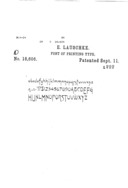This typeface is best known by its 20th century name, Pekin. But although it was marketed in that century as a faux oriental face, it was not designed as one. More interestingly, as Steve Watts demonstrated in 1958, it has unusual potential as set of abstract ornaments (both because of its design and because of the way it was cast and trimmed).
Originally by Ernst Lauschke for Barnhart Brothers & Spindler (US design patent No. 18,606, 1888-09-11). Issued as Dormer.

US Design Patent 18,606 (1888, Lauschke)
US design patent 18,606, "Design for a Font of Printing-Type." Issued 1888-09-11 to Ernst Lauschke. Filed 1888-08-02 as application serial no. 281,818. Assigned to Barnhart Brothers & Spindler
It was shown in the The Inland Printer, Vol. 5, No. 10 (July 1888): 753 (Annenberg reprints this on p. 234 of A Typographical Journey through the Inland Printer.)
(Scan by DMM from an original at the University of Wisconsin. Clicking on the image above will bring up the entire original page as scanned.)
The earliest BB&S specimen presently (2013) online which shows Dormer is the "Big Blue Book" dated by Annenberg to circa 1896.
(From the Google Books scan of a University of California copy, available via The Hathi Trust. Hathi ID: uc1.31822038209771.)
It is interesting to see it shown above in the context of "Freak." While Dormer (renamed Pekin) was marketed in the 20th century as a fake oriental face, and while it happens to fit 20th century notions of what such a typeface would look like, it was clearly designed simply as another "extreme" typeface of the 1880s.
BB&S mats numbered as ATF Series 1827 (as Pekin). I'm not sure if they actually cast it on their own.
In 1958, Steve L. Watts had ATF recast the face for him in the 18 point size as a part of his Kittypot Castings series. Here is an extract from the prospectus for this casting:
(The full document from which this was extracted is online at in the Steve L. Watts Notebook at: "Delightes for Typewranglers & Bookwormes".)
Watts' point about the flush top and bottom trim of this type is an interesting one. Type is cast against molds (called "matrices"), and the sides of the casting cavity in the matrix must be slightly angled. (In more general casting terms, all molds must have draft.) This means that the beards of all types as cast must be slightly angled. Since one typically casts type so that the bottom of the beard is inside the dimensions of the type (in set and body size), typically the printing face of a type must be smaller than the set width and point size of the type.
However, it is possible to cast type so that the beard (but in this case not the face) overhangs the side of the body of the type. This beard may then be trimmed off (either automatically in some typecasting machines or by hand). In this way, it is possible to create a type the face of which is trimmed flush with one or more of the four sides of the type body. This is of course a bit more labor intensive; it is going to require nice work in alignment and possibly extra work in dressing the types.
Because Pekin is a relatively geometrical face, and because, as Watts notes, it was cast and trimmed so that the face was flush at the top or bottom (or both), it may be used as a font of abstract geometric ornaments.
No previous showing of Pekin/Dormer mentions this characteristic, so it isn't completely certain that prior to the casting for Watts it was so trimmed. However, this was a point-system face from the beginning, and the original 1889 BB&S mats were used for all castings through this one. Neither the size of the printing face of this type nor the size of type bodies had changed since its introduction. Logically, it seems as if this type must always have been cast with beards overhanging the bodies (top and bottom) which were then trimmed flush.
Mats copied in 18 point (not sure from which source) for Typefounders, Inc. (of Phoenix). Shown by their December 1962 Specimen No. 7A.
Phoenix mats to Los Angeles Type Founders and thence to Barco / F&S. I presume that LATF, at least, cast it, but I am not sure of this.
Phoenix mats currently owned by Skyline Type Foundry.
All of the type specimen documents reproduced or extracted from here are in the public domain due to their publication without copyright notice when such notice was required, or the failure to renew copyright as was then required, or the expiration of all possible copyright. The reproductions of/from them here remain in the public domain.
All portions of this document not noted otherwise are Copyright © 2013 by David M. MacMillan and Rollande Krandall.
Circuitous Root is a Registered Trademark of David M. MacMillan and Rollande Krandall.
This work is licensed under the Creative Commons "Attribution - ShareAlike" license. See http://creativecommons.org/licenses/by-sa/3.0/ for its terms.
Presented originally by Circuitous Root®
Select Resolution: 0 [other resolutions temporarily disabled due to lack of disk space]